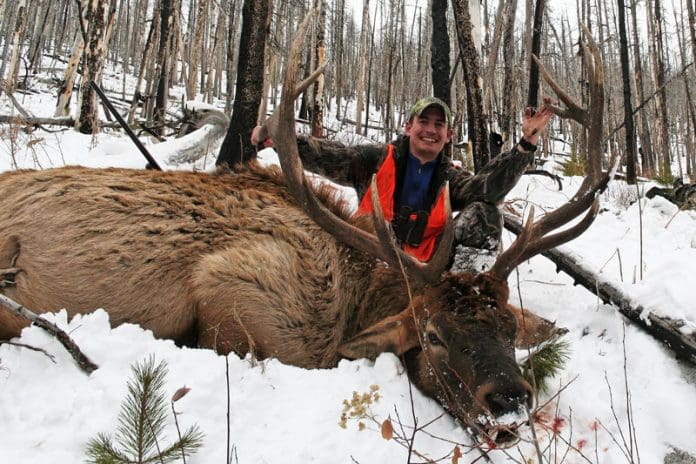“Extended” Range Riflescope Showdown:
By Matt Cashell
As I crested the ridge, my hunting partner, Jared, whispered to me, “They’re still there! He’s up and feeding.” I settled behind my binoculars and looked over two bulls munching their way through a huge burned slope. I had spotted these bulls bedded at first light from a cliff face a couple miles away about an hour earlier. Now there was nothing between us and the elk but wide open burn. There was no getting closer, and the bulls had no idea we were there. I set up my shooting sticks and got a steady rest. Jared got a range of 460 yards. I checked my data and dialed the drop on my riflescope. I took a deep breath, let it half way out and held it … “BOOOM……..THWAK” The sound of solid hit filtered back across the canyon to us., and my biggest bull to date was waiting for trophy photos.
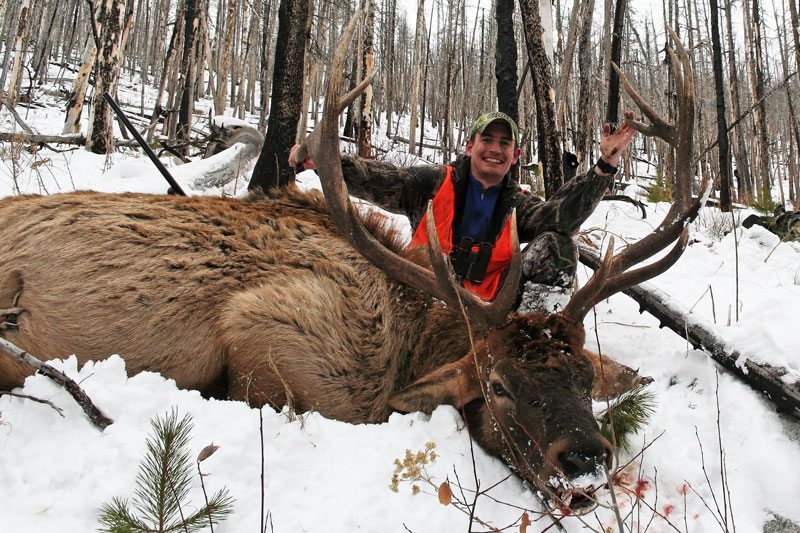
Confidently shooting past traditional ranges allowed the author to take this bull.
Hunting wide open country like alpine basins and giant open burns of the West provide for some interesting challenges to the rifle hunter including a lack of cover. Extending your effective range can really increase your chances of a successful hunt. Long range hunting is really the rage right now, and some really long range kills are being made at distances in excess of 1200 yards. I am not reviewing these scopes from the point of view of those extreme range hunters, but more for the hunter that wants to increase his confident range and odds of success.
I decided to evaluate some popular scope choices for hunters extending their range: They included a 4.5-14X50 Leupold Mark 4 M1 dials w/ TMR (Tactical Milling Reticle), a 4-16X50 Vortex Viper PST MIL/MIL SFP (Second Focal Plane), and a 4-12X50 Swarovski Z3 w/ BRH (Ballistic Reticle – Hunting) reticle. The Mark 4 and PST are “Dual Use” scopes that have tactical shooting features, but also work well for hunters extending their range. The Z3 was designed as a hunting scope with extended range capabilities. The common advertised price for the Mark 4 was $1199. The Z3 is advertised at $999. The PST in SFP was the most affordable, running $699. The Leupold and Swarovski are assembled in the USA. The PST is made in the Philippines.
The three scopes have some similarities. All three have 50mm objectives that are well matched with their maximum magnifications for low light use. All three have Second Focal Plane (SFP) reticles calibrated at the maximum magnification. All three are warranted for life by companies with reputations for top-notch customer service. There were plenty of differences, however, and I thought I would split the comparison into three major areas: Optical Performance, Features, and Mechanical Performance.
Optical Performance:
One scope stood out in optical performance. The Swarovski Z3 showed vibrant, neutral images with remarkable centerfield performance. I have yet to see a really Chromatic Aberration (CA) free riflescope, but the Z3 does an excellent job showing very little at center of the field, and low intensity purple CA at the edge. I could actually resolve more detail through the Swarovski at 12x as I could through the Leupold at 14x (actual magnification 14.3x). It took the PST a full 16x to resolve any more detail than the Z3 at 12x. The image also had excellent contrast, providing for bright and vibrant colors. The Swarovski’s image advantage was most notable in low light. The edge of the field, like most riflescopes, had some reduction in performance, but overall the Z3 had a spotting-scope like image. The Swarovski also had a very impressive field of view. This would be especially useful for getting on target quickly. There was no noticeable tunneling.
The Mark 4 also had a great image, right up to maximum power. It matched the Swarovski at similar powers in every area except raw resolution. CA control was very good with slightly more intense CA at the edge. When both scopes were at 12x, the Swarovski would show a little more detail, but the Mark 4 maintained a very nice image. In good light the Mark 4 had excellent contrast, making picking out targets a breeze. In low light, the contrast suffered a little more in the Mark 4 than the Swarovski, but both were a little ahead of the PST at max power. The Mark4 suffered from “tunneling” from around 8x down to 4.5. Tunneling is the phenomena where the field of view did not get wider under around 8x. So the only real advantage of going down in power under 8x with the Leupold was to get a larger exit pupil.
The PST’s optical performance is very good. In fact at lower magnifications it performs quite similarly to the Mark 4. Only at the very max magnification (16x) the PST suffers a small loss of contrast. This makes the image seem a little “grayer” or “milky” when compared side-by-side with the other scopes in this comparison. At max power, it is also a little picky on eye position. However, it still performed very well in resolution testing. At 12x (I had to kind of guess as 12x is not marked on the magnification ring) is still resolved the same amount of detail as the Mark 4. In fact, at 12x the PST maintained high levels of contrast as well. When all scopes are at their respective maximum magnification, even with the reduced contrast, the PST still resolved the most detail of all three scopes, almost certainly due to its magnification advantage. The PST showed no signs of tunneling. Overall, the PST performs very well optically, and is on the heels of the more expensive competition.
Optically, the Swarovski stood out in optical performance. However, all three have quality images sufficient for serious long range shooting.
Features:
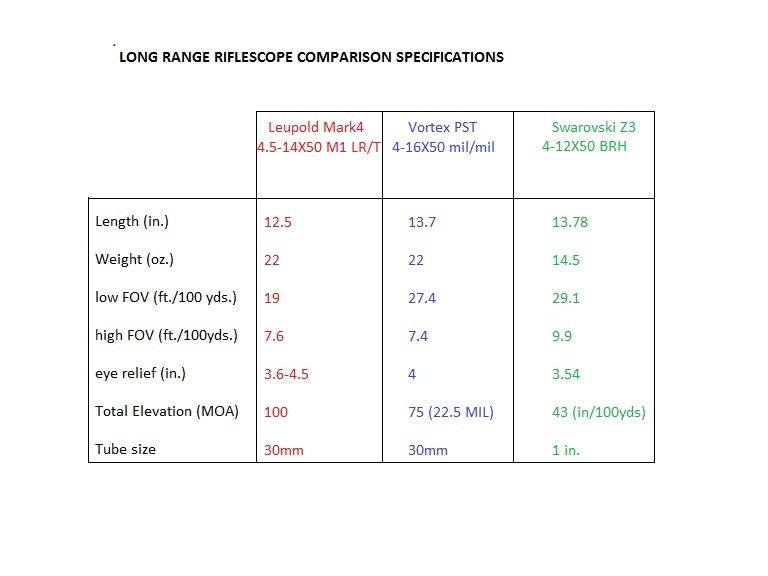
As you can see from the chart, the Swarovski has a significant weight advantage, even though it is also the longest scope. It is also very sleek and slender. The scope gets in and out of scabbards, backpacks, and rifle cases very easy due to its sexy form factor. The other two scopes are chunky and utilitarian. They have large, exposed tactical knobs that could prove to be a challenge for scabbards and packs.
The PST offers an etched and illuminated reticle. The illumination is very nice and does not “bleed” into the FOV. Only the highest setting is daylight visible, and it is barely that. This feature is very useful in low light, and especially varmint hunting at night. The illumination dial had positive clicks with an “off” setting between illumination settings. The EBR-1 is quite thin, but the illumination makes it useable in any light. The EBR-1 Mil reticle is subtended in mils, which are also marked in the reticle (see photo).
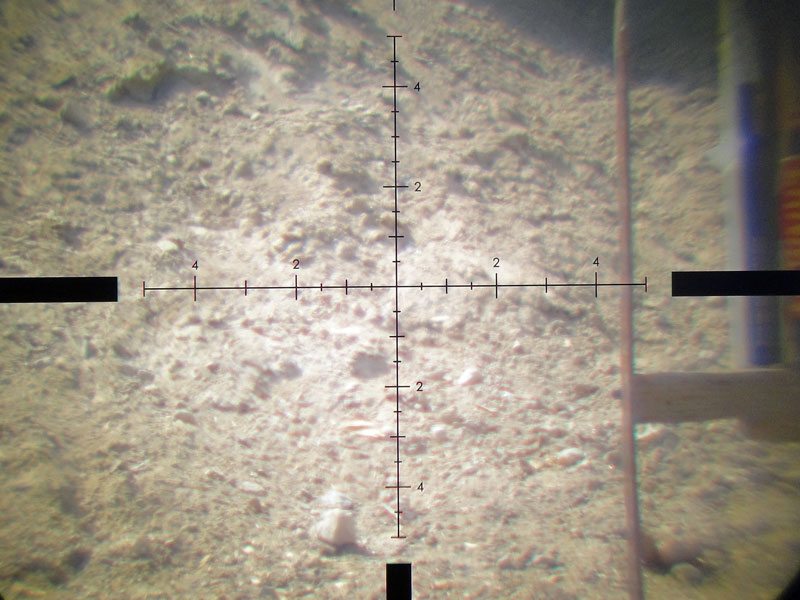
Vortex’ EBR-1 reticle
The Second Focal Plane reticle is subtended at max magnification (16x). The magnification ring has a really nice feature for a SFP scope in that magnifications are marked with a “Reticle Multiplier” where you simply multiply the subtensions to be accurate at that magnification. The ring also has tactile detents to let you know you are exactly on the multiplying magnification. Very handy, especially if you want to use the reticle in low light, but need a lower magnification for a larger exit pupil.
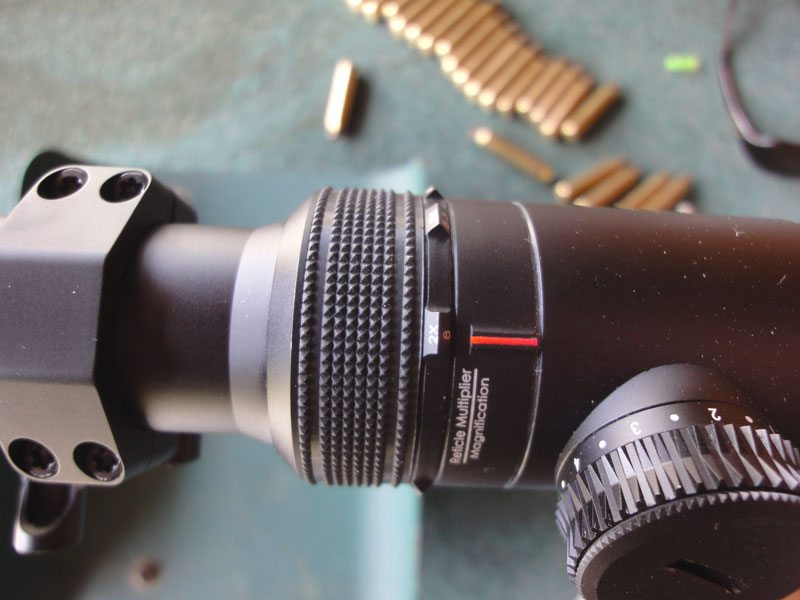
The Viper PST has markers at magnifications where the sub tensions have multiplied.
The Z3 has the BRH reticle, which is a simple “Christmas tree” style reticle designed with hunters in mind. The reticle is subtended in 0.5 MILs at maximum magnifcation, so you can use any ballistic calculator to get your drops. Or you can use Swarovski’s online calculator or downloadable app. The windage bars have a mark for windage aiming at 5 and 10 mph. These are accurate enough with most loads to be useful in a hunting situation. While not a heavy reticle, the BRH is heavier than the BRX reticle, and is much more suited to low light use than the BRX was, as the BRX was so thin many shooters found it hard to see in low light
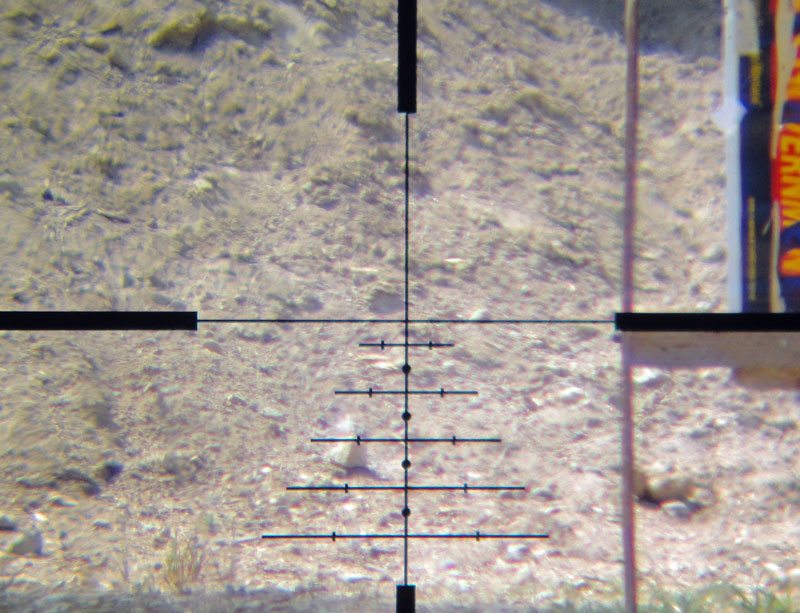
Swarovski’s BRH reticle.
The Mark 4 has Leupold’s Tactical Milling Reticle (TMR). This is a mil-based hash style reticle like the EBR-1 without the numbered stadia. It also has a gap at the center for an unobstructed aiming point. I like the reticle a lot for the same reasons I like the EBR-1. The TMR is thin, but a little bit thicker than the EBR-1. Some may find the TMR too thin in really low light. Illumination would alleviate this issue, and it is available in this scope, for a price. I did not find the open aiming point hard to use, or particularly beneficial, either. I would prefer the hashes to be marked like the EBR-1.
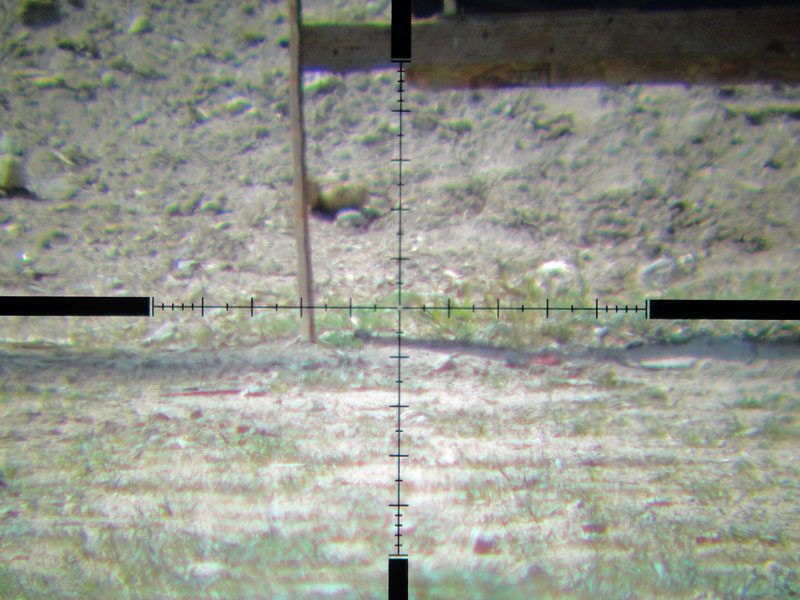
Leupold’s TMR reticle
Regarding parallax setting: Both the PST and Mark4 have accurate, repeatable side focus knobs that allow the user to eliminate parallax error at any range. The Z3 with BRH is set by the factory at 200m. This allows for a small amount of error at 100 yards, which is something to keep in mind when zeroing and load development. I do like the 200m set parallax for hunting, however, because it mitigates parallax error out to extended ranges, but requires no “fiddling” in the field. It also can’t be bumped off the setting. On the SF scopes, I am tempted to set them at 200 yards for hunting, and only adjust when I have extra time to set up for the shot. The SF scopes are nice for load development and sighting in.
Mechanical Performance:
All of the reticles were PERFECTLY subtended according to the CATS targets. All of them were free of cant as well. I tested cant by running the elevation adjustment from end to end while the rifle was in the vise, and checking the reticle on the vertical target line.
I received some excellent CATS calibration targets from Horus Vision to test the scopes for adjustment accuracy. These targets have lines in MILs and MOA. You can either test tracking by putting the scoped rifle in a vise and watching the reticle travel, or shooting, adjusting, and shooting again. I chose both methods, and all three scopes tracked perfectly. It is important to remember that the Swarovski has click values in ¼ in./per 100 yards, so it tracked shy of the corresponding MOA measurement towards the end of the travel.
The Z3 turrets were low profile, covered, traditional turrets. They were finger-adjustable with an extra-firm and positive click. You can easily reset the zero mark by pulling up on the turret collar, spinning the zero mark to the witness mark, and pushing the turret collar back down. While the scope tracked well in its marked measurement, it is not really designed for dialing drops. The intention is to use the reticle for holdover. The scope is also offered with a ballistic turret, and it would work well, but the scopes internal travel is limited, so it would be most useful for less than extreme distances.

The Swarovski Z3’s low profile capped turrets are finger adjustable.
The Mark4 turrets were the same M1 ¼ MOA turrets Leupold has been using for decades. The turrets have a soft, but tactile feel and click audibly. They kind of remind me of a baseball card in bicycle spokes. The clicks don’t provide much resistance, but you can feel and hear the clicks as you spin the turret. They are well marked with revolution witness marks to keep you on the right rotation. I worked this scope through the full elevation travel several times, and it had no problem returning to an absolute zero. The turrets have three allen wrench set screws for setting and changing the zero mark.
The PST turrets are calibrated in 1/10 MIL to match the reticle. This is a huge advantage. I was able to zero the scope in two shots. I shot once, measured to the impact hole using the reticle, and dialed what I measured. Second shot was dead nuts. Every scope should have clicks that are calibrated in the same angular unit of measurement as the reticle. The clicks were much more tactile and positive than the Mark 4, but I would have preferred a little more resistance. The turrets have revolution witness marks, but the scope also comes with shims the shooter can use to stack on the interior of the turret to make a rotation stop. Once set, the shooter can go up more than one revolution and just turn the turret back until it stops, then line up the zero, and the shooter is back to zero. While not a true zero-stop, the system is easy to set up and functional. Like the Mark4, the PST returned to zero without a hiccup over and over. With over 22 MILs (75 MOA) of drop adjustment, the PST has plenty of adjustment, but is shy of the Mark4‘s 100 MOA. Both scopes benefit from a 20 MOA mount to provide for maximum range of adjustment.
Conclusion:

The Swarovski Z3, Vortex Viper PST, and Leupold Mark4 LR/T (left to right)
The Swarovski Z3 w/ BRH is an excellent traditional hunting scope with an extremely useful and versatile reticle for extended range hunting use. The reticle gives aiming points out to 700 to 800 yards for most cartridges. The system is simple, easy to use in the field, and has few adjustments that can go wrong on a hunt. This scope is the optical champ of the test and gives a top notch view of the target, even under adverse conditions. The scope is also very user friendly, as no adjustments are necessary in the field, other than selecting the right aiming point. This scope brings extended range performance at a backpacking weight.
The Vortex Viper PST MIL/MIL offers a ton of features for a moderate price. You get solid optical performance, dead nuts tracking, rotation stop, illumination, four inches of constant eye relief, matching units of measurement for reticle and turrets, great turret feel, and nice touches like the reticle multiplier, all for hundreds of dollars less than the other scopes in the test. The Vortex name is synonymous with value, and they hit that mark with this scope.
The Leupold Mark4 LR/T has been the benchmark for tactical scopes for a long time. The scope I tested lived up to that pedigree in many ways, tracking well, and offering a great optical image in a robust and durable package. The variable eye relief, tunneling, and less-than-positive click feel detract from an otherwise well-balanced riflescope. These slip-ups were noticeable, given the price point. The variable eye relief alone had me adjusting my cheek weld about an inch on the comb of the rifle between the lowest magnification and highest magnification.
Of these three scopes, I like the Swarovski best for a lightweight, but extended range-capable field rifle. I like the PST for a dedicated extended (and further) range rig where weight and size are less important and there is a lot of turret spinning and wind-doping involved. While the Mark4 is still a high quality and capable scope, I wouldn’t choose it over the others, especially when considering it was the most expensive scope I tested.














